- Home
- Lauren Willig
The Mark of the Midnight Manzanilla
The Mark of the Midnight Manzanilla Read online
PRAISE FOR THE NOVELS
OF LAUREN WILLIG
The Passion of the Purple Plumeria
“This tenth bloom to be added to Willig’s popular series is just as fresh and satisfying as any of the other flowers in the best literary bouquet ever created! Fans can rejoice in finding the outstanding features they’ve come to count on: intriguing historical details, double-crossing deceptions, complex characters, and plenty of romance.”
—Library Journal (starred review)
“With delectable wit and a deft hand at imaginative plotting, Willig expertly matches up the redoubtable, parasol-wielding Gwen with the perfect hero. The result is a completely captivating tale that fans of this long-running series will cherish.”
—Booklist (starred review)
“Another well-crafted, engaging thriller.”
—Romantic Times
“[A] witty series. . . . The writing is acerbic, arch, and funny . . . a welcome installment.”
—Kirkus Reviews
The Garden Intrigue
“Eloise, of course, is amazing, but it’s truly the plot of The Garden Intrigue that shines . . . wonderful!”
—Romance Junkies
“Enlightening and entertaining as always, and full of plenty of romance and intrigue.”
—Library Journal
“As fresh and charming as its floral theme.”
—Kirkus Reviews
“Humor, love, espionage—yet again there is absolutely nothing that this incredible author leaves out. . . . [These stories] just keep getting better and better every time!”
—Once Upon a Romance
The Orchid Affair
“Supremely nerve-racking . . . successfully upholds the author’s tradition of providing charming three-dimensional characters, lively action, [and] witty dialogue.”
—Library Journal
“Willig’s sparkling series continues to elevate the Regency romance genre.”
—Kirkus Reviews
“Willig combines the atmosphere of the tempestuous era with the perfect touches of historical detail to round out the love story.”
—Romantic Times
The Betrayal of the Blood Lily
“Newcomers and loyal fans alike will love . . . Willig’s signature mix of historical richness and whimsical humor.”
—The Newark Star-Ledger
“Willig hasn’t lost her touch.”
—Publishers Weekly
“Willig injects a new energy in her already thriving, thrilling series, and presents the best entry to date.”
—Booklist
The Temptation of the Night Jasmine
“Jane Austen for the modern girl . . . sheer fun!”
—New York Times bestselling author Christina Dodd
“An engaging historical romance, delightfully funny and sweet. . . . Romance’s rosy glow tints even the spy adventure that unfolds . . . fine historical fiction.”
—The Newark Star-Ledger
“Another sultry spy tale. . . . The author’s conflation of historical fact, quirky observations, and nicely rendered romances results in an elegant and grandly entertaining book.”
—Publishers Weekly
“[A] high-spirited and thoroughly enjoyable series.”
—Kirkus Reviews
The Seduction of the Crimson Rose
“Willig’s series gets better with each addition, and her latest is filled with swashbuckling fun, romance, and intrigue.”
—Booklist
“Handily fulfills its promise of intrigue and romance.”
—Publishers Weekly
“There are few authors capable of matching Lauren Willig’s ability to merge historical accuracy, heart-pounding romance, and biting wit.”
—BookPage
The Deception of the Emerald Ring
“History textbook meets Bridget Jones.”
—Marie Claire
“A fun and zany time warp full of history, digestible violence, and plenty of romance.”
—New York Daily News
“Heaving bodices, embellished history, and witty dialogue: What more could you ask for?”
—Kirkus Reviews
“Smart . . . [a] fast-paced narrative with mistaken identities, double agents, and high-stakes espionage. . . . The historic action is taut and twisting.”
—Publishers Weekly
The Masque of the Black Tulip
“Clever [and] playful. . . . What’s most delicious about Willig’s novels is that the damsels of 1803 bravely put it all on the line for love and country.”
—Detroit Free Press
“Studded with clever literary and historical nuggets, this charming historical-contemporary romance moves back and forth in time.”
—USA Today
“Willig has great fun with the conventions of the genre, throwing obstacles between her lovers at every opportunity . . . a great escape.”
—The Boston Globe
The Secret History of the Pink Carnation
“A deftly hilarious, sexy novel.”
—New York Times bestselling author Eloisa James
“A merry romp with never a dull moment! A fun read.”
—New York Times bestselling author Mary Balogh
“This genre-bending read—a dash of chick lit with a historical twist—has it all: romance, mystery, and adventure. Pure fun!”
—New York Times bestselling author Meg Cabot
“Willig has an ear for quick wit and an eye for detail. Her fiction debut is chock-full of romance, sexual tension, espionage, adventure, and humor.”
—Library Journal
“Willig’s imaginative debut . . . is a decidedly delightful romp.”
—Booklist
“Relentlessly effervescent prose . . . a sexy, smirking, determined-to-charm historical romance debut.”
—Kirkus Reviews
“A delightful debut.”
—Roundtable Reviews
ALSO BY LAUREN WILLIG
The Secret History of the Pink Carnation
The Masque of the Black Tulip
The Deception of the Emerald Ring
The Seduction of the Crimson Rose
The Temptation of the Night Jasmine
The Betrayal of the Blood Lily
The Mischief of the Mistletoe
The Orchid Affair
The Garden Intrigue
The Passion of the Purple Plumeria
New American Library
Published by the Penguin Group
Penguin Group (USA) LLC, 375 Hudson Street,
New York, New York 10014
USA | Canada | UK | Ireland | Australia | New Zealand | India | South Africa | China
penguin.com
A Penguin Random House Company
First published by New American Library,
a division of Penguin Group (USA) LLC
Copyright © Lauren Willig, 2014
Readers Guide copyright © Penguin Group (USA) LLC, 2014
Penguin supports copyright. Copyright fuels creativity, encourages diverse voices, promotes free speech, and creates a vibrant culture. Thank you for buying an authorized edition of this book and for complying with copyright laws by not reproducing, scanning, or distributing any part of it in any form without permission. You are supporting writers and allowing Penguin to continue to publish books for every reader.
REGI
STERED TRADEMARK—MARCA REGISTRADA
LIBRARY OF CONGRESS CATALOGING-IN-PUBLICATION DATA:
Willig, Lauren.
The mark of the midnight manzanilla: a Pink carnation novel/Lauren Willig.
p. cm.—(Pink carnation 11)
ISBN 978-0-698-14686-0
1. Vampires—Fiction. I. Title.
PS3623.I575M35 2014
813'.6—dc23 2014010559
PUBLISHER’S NOTE
This is a work of fiction. Names, characters, places, and incidents either are the product of the author’s imagination or are used fictitiously, and any resemblance to actual persons, living or dead, business establishments, events, or locales is entirely coincidental.
Version_1
Contents
Praise
Also by LAUREN WILLIG
Title page
Copyright page
Dedication
Prologue
Chapter One
Chapter Two
Chapter Three
Chapter Four
Chapter Five
Chapter Six
Chapter Seven
Chapter Eight
Chapter Nine
Chapter Ten
Chapter Eleven
Chapter Twelve
Chapter Thirteen
Chapter Fourteen
Chapter Fifteen
Chapter Sixteen
Chapter Seventeen
Chapter Eighteen
Chapter Nineteen
Chapter Twenty
Chapter Twenty-one
Chapter Twenty-two
Chapter Twenty-three
Chapter Twenty-four
Chapter Twenty-five
Chapter Twenty-six
Chapter Twenty-seven
Chapter Twenty-eight
Acknowledgments
Historical Note
About and Author
READERS GUIDE
Excerpt from The Lure of the Moonflower
To my mother,
Rosette F. Willig,
for everything and more.
Prologue
Cambridge, 2004
“Vampire: Fact or Fiction?” announced Megan grandly.
An undergrad reading Kant in German raised a brow and went back to her critique of pure reason. The tourists at the table next to us edged their plastic chairs ever so slightly towards the other side, bumping into a potted plant in the process.
“So you’ve picked a title, then?” I said.
Megan shrugged. “It’s a little over-the-top, but I thought, why not? It’s almost Halloween, after all.”
So it was. I’d been back in the U.S. for nearly three months now. We’d gone from the sticky heat of late August in Cambridge, the campus deserted except for the sleepy flies on the windowsills and a handful of stressed-out grad students in their carrels at Widener Library, to the Indian summer of September, when bewildered freshmen roamed the streets in defensive herds, turning up at the wrong buildings and crowding the tables at Au Bon Pain. It was October now. The freshmen had settled into their dorms; the upperclassmen were out and about, belatedly buying their course books at the Coop and arguing loudly about existentialism in the upstairs room of Café Algiers.
Summer seemed like a very long time ago. Sometimes, as I scurried from Widener to Robinson Hall, books clutched in one arm, a Vietnamese coffee from Toscanini’s dripping on the other, it seemed hard to believe that I had ever left, had ever spent a year in England, had ever lived—albeit temporarily—in a Georgian manor in Sussex with an Englishman named Colin.
It sounds like something out of a chick flick, doesn’t it? Take one American graduate student on her research year in England, wearing reasonably cute boots, add a set of family archives and the handsome but mysterious owner thereof. Cue dramatic music.
Of course, in real life, it was all a great deal more prosaic than that.
Admittedly, when I’d first met Colin, he’d done his best to impersonate Mr. Rochester, if Rochester had been blond and given to wearing an ancient Barbour jacket. Despite those impediments, Colin had managed to brood quite forbiddingly when I’d requested access to his family archives. He was rather protective of the family heritage, which contained a truly dramatic number of undercover agents.
There was a time when I’d wondered if Colin might be one himself.
But I was over that now. Mostly. In any case, the only agents of whom I was officially on the trail were all two centuries gone. My mission was to winkle out their escapades—and turn them into footnotes in my dissertation: Aristocratic Espionage During the Wars with France, 1789–1815.
With enough academese, even swashbuckling spies can be rendered dry as dust.
But that was just a front. The truth of the matter was that my interest had long since become less about the dissertation and more a personal involvement with the people whose escapades I was reconstructing, piecemeal, from a sometimes conflicting array of documents. I was meant to be studying all three of the major British spy leagues—the Scarlet Pimpernel, the Purple Gentian, and the Pink Carnation—but my interest had come to focus more and more narrowly on the Pink Carnation.
I could find all sorts of ways to justify it: the Carnation was in operation much longer, and therefore made a better case study; the League had experimented with different techniques and methods, which told us something about the evolution of aristocratic spying from an ad hoc endeavor to a quasi-professional enterprise. And, of course, the Carnation was a woman, one Miss Jane Wooliston, who, with the help of her erstwhile chaperone, Miss Gwendolyn Meadows, had hoodwinked Napoleon for close on a decade. It was so simple that it was genius. Who would suspect a demure lady of society to be fronting the most audacious undercover enterprise since Odysseus came up with the bright idea of knocking a few wooden slats together and calling them a horse?
At least, that was how the League of the Pink Carnation had operated during the first three years of its existence. I’d blithely assumed that the Pink Carnation had gone on that way, refining her technique without changing it. But documents I’d found just before I left England had held out the tantalizing prospect that, in fact, the Pink Carnation had precipitated a major shake-up at some point in 1805, switching from the existing League structure to something more like a solo agent.
I was itching to uncover more. Why had the Pink Carnation broken with her longtime partner and chaperone, Miss Gwendolyn Meadows, in 1805? Was it because of Miss Gwen’s marriage and subsequent success as a novelist? Or was that just a guise? Were the Pink Carnation and Miss Gwen really still in partnership, albeit operating on different fronts, Miss Gwen in London, the Pink Carnation abroad?
It seemed as though every thread I followed led not just to another thread but to a whole skein of them, all waiting to be unraveled. But instead of unraveling them, here I was, back in the wrong Cambridge, laying waste my hour trying to drum Western Civ, 1650 to the Present, into the heads of two sections of uninterested undergrads, while also wrangling a bunch of disaffected teaching fellows. I’d promised to take the Head TF job for Western Civ, so dutifully back to the States I had come, leaving my mysteries unsolved.
And Colin back in England.
Megan said something. I gave a little shake of my head and forced myself to try to pay attention. “Sorry. What was that?”
Megan and I had gotten into the habit of a weekly Thursday lunch at Campo de Fiore, the tiny pizza place in the middle of the Holyoke Center, before sallying off to teach our respective Hist and Lit tutorials. Megan was the Lit, I was the Hist, but undergrads who hadn’t done the reading were undergrads who hadn’t done the reading however you looked at it. It was easier to deal with them after a fortifying lunch heavy on the carbohydrates and caffeine.
Sometimes we met for a restorative drink
after as well, but this wasn’t going to be one of those days.
Megan looked at me sympathetically. “No problem,” she said, and took a bite of her potato pizza. Through a mouthful of spud and crust, she said indistinctly, “When does Colin get here?”
I checked my watch, which hadn’t moved very far from the last time I had checked it. “His plane gets in around four.”
By which time my apartment would be clean and sparkling, there would be groceries in the fridge, and all stray bits of spinach would have been removed from my teeth. Or at least the spinach bit. My tutorial ran from one to three. With any luck, it would take Colin a while to get a cab, thus giving me more time to repair the wear and tear of teaching and scrub the miscellaneous coffee stains off my person.
Megan leaned forward, the wooden beads of her necklace narrowly missing the straw sticking out of her Diet Coke. “Are you nervous?”
Me? Nervous? I jabbed at an ice cube with my own straw. “We talk every day.”
Some days longer than others. With Colin five hours ahead, we tended to speak at odd times; it was either insanely early my time or late at night his. Not to mention transcontinental rates being what they were, even with a good deal on a long-distance calling card. I was managing on a teaching fellow’s income and Colin had a money-guzzling old house to support. Which meant, in sum, that four nights out of five, our phone calls were little more than a pro forma “just to hear your voice.”
It’s amazing how quickly someone familiar can start to feel alien and how pro forma that pro forma becomes.
I had left a toothbrush in the holder at Selwick Hall and two sweaters and a nightgown in “my” drawer. At Colin’s insistence, I might add. It was as if we were both afraid that absence might break the fragile thing we had built between us, as if we might tether ourselves together across the Atlantic through the magical invocation of the bristles of an Oral-B and a J.Crew cashmere-merino blend.
Sometimes, I took comfort from the fact that my toothbrush was still there. Other times, in the twilight, when I was tired from teaching and alone in my little studio apartment, in those dreary moments when the sun has gone down but you haven’t quite turned on the lights, a purple plastic toothbrush seemed a very fragile object on which to build my future happiness.

 That Summer
That Summer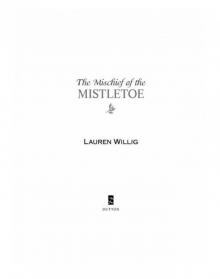 The Mischief of the Mistletoe
The Mischief of the Mistletoe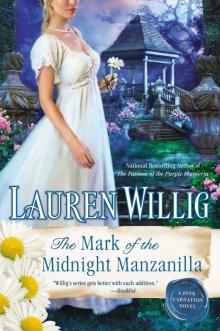 The Mark of the Midnight Manzanilla
The Mark of the Midnight Manzanilla The Other Daughter
The Other Daughter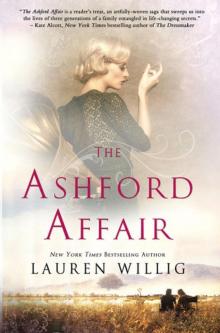 The Ashford Affair
The Ashford Affair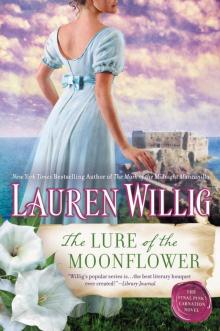 The Lure of the Moonflower
The Lure of the Moonflower The Secret History of the Pink Carnation
The Secret History of the Pink Carnation The Masque of the Black Tulip
The Masque of the Black Tulip The Passion of the Purple Plumeria
The Passion of the Purple Plumeria The English Wife
The English Wife The Garden Intrigue
The Garden Intrigue Ivy and Intrigue: A Very Selwick Christmas
Ivy and Intrigue: A Very Selwick Christmas The Orchid Affair
The Orchid Affair The Summer Country
The Summer Country The Betrayal of the Blood Lily
The Betrayal of the Blood Lily The English Wife: A Novel
The English Wife: A Novel Masque of the Black Tulip pc-2
Masque of the Black Tulip pc-2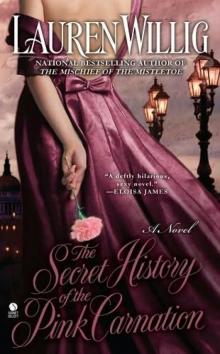 The Secret History of the Pink Carnation pc-1
The Secret History of the Pink Carnation pc-1 That Summer: A Novel
That Summer: A Novel The Mischief of the Mistletoe: A Pink Carnation Christmas
The Mischief of the Mistletoe: A Pink Carnation Christmas